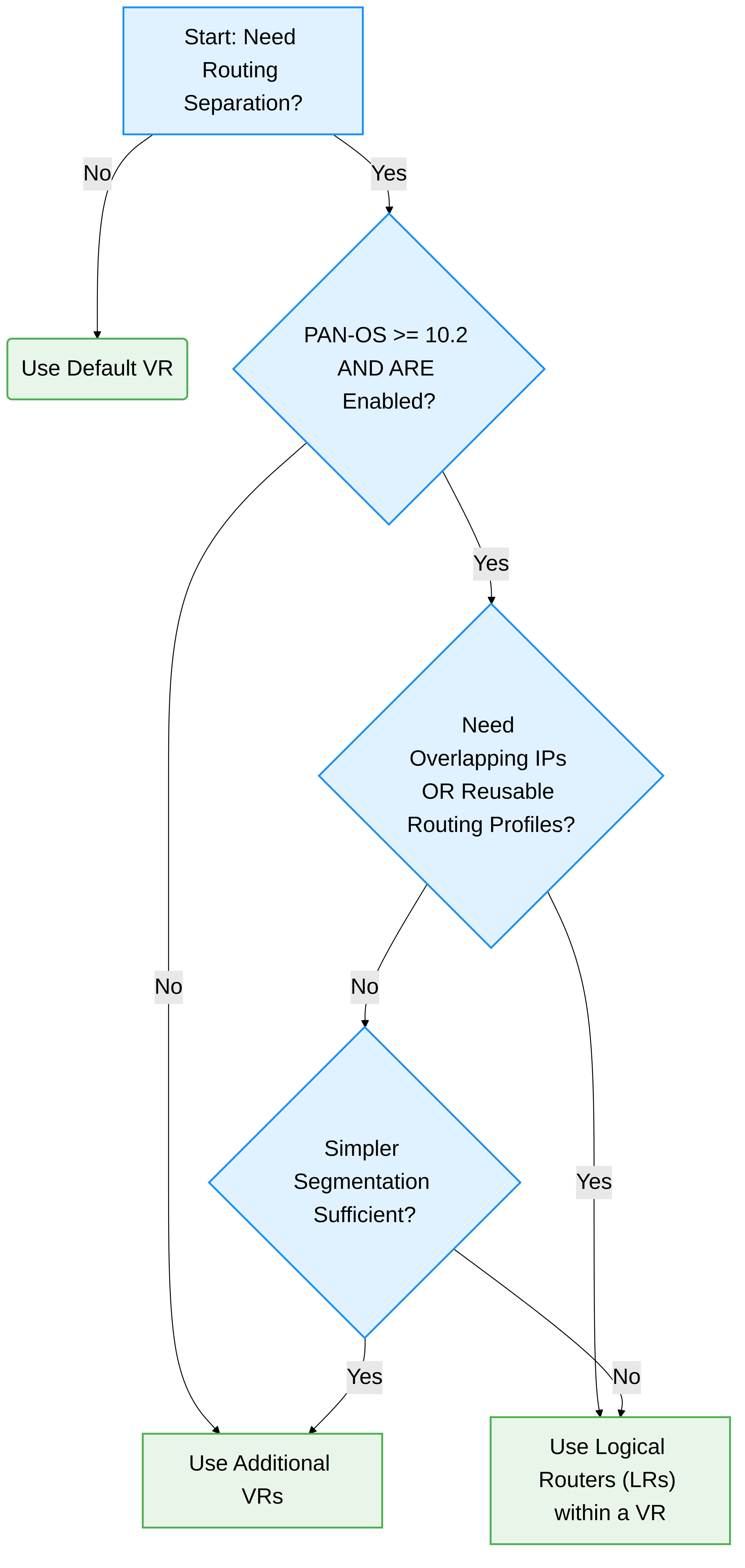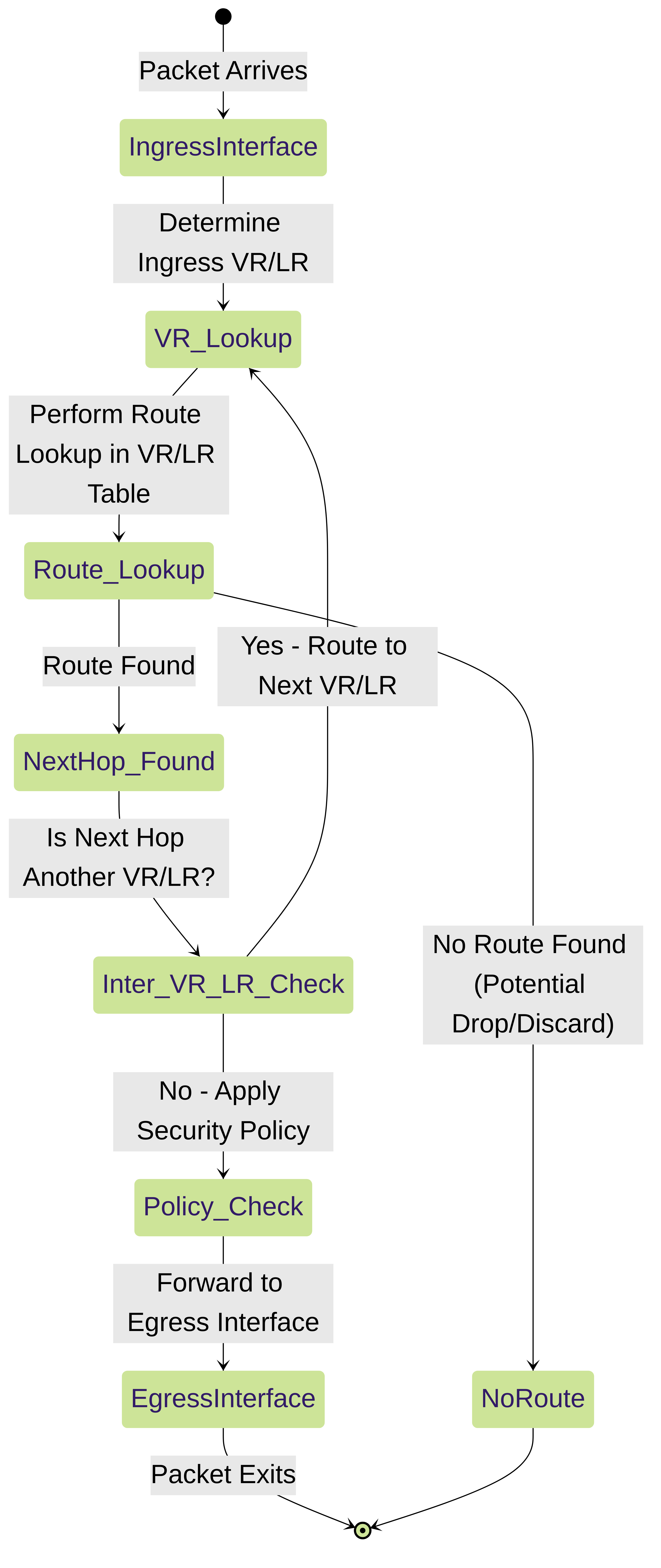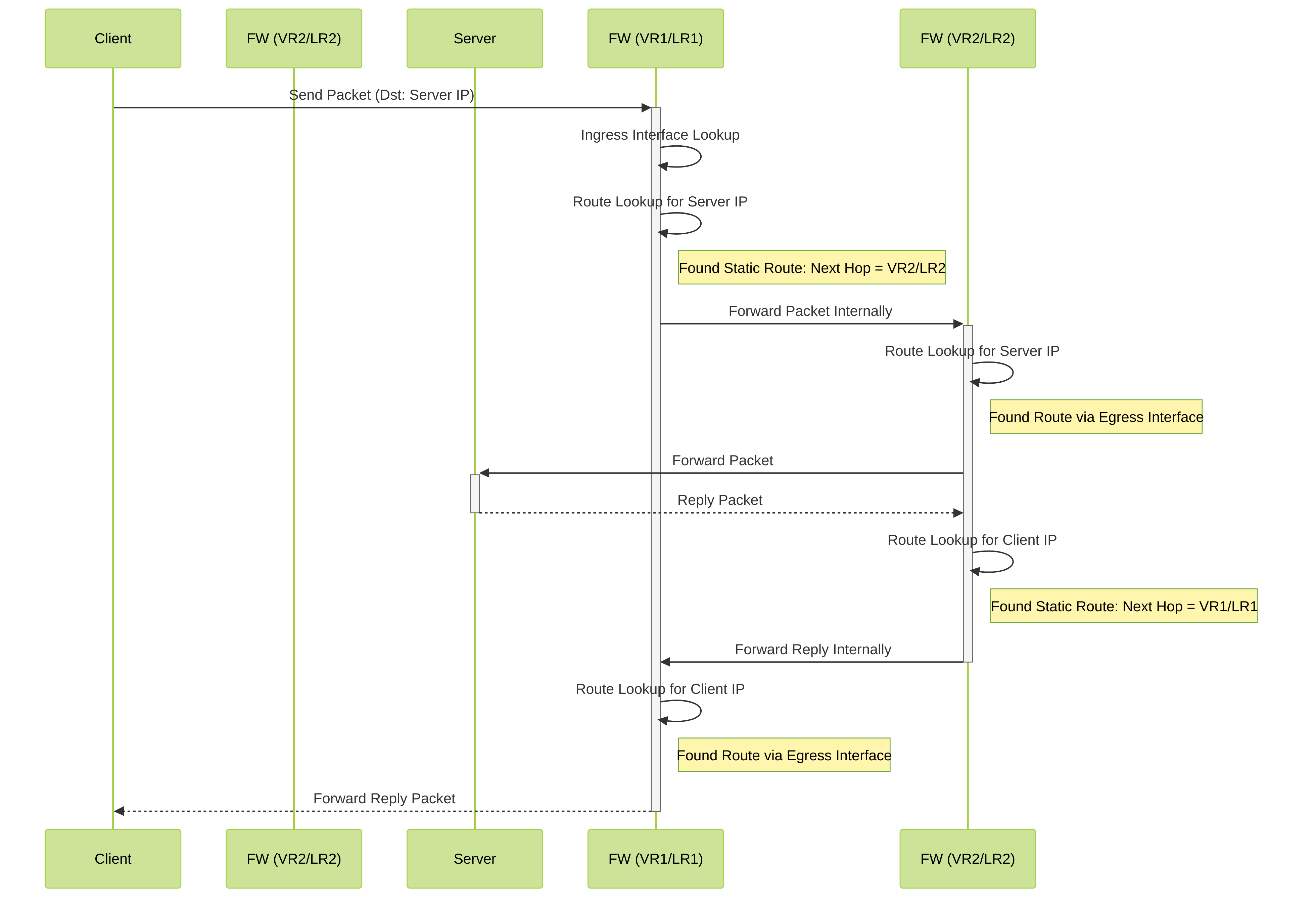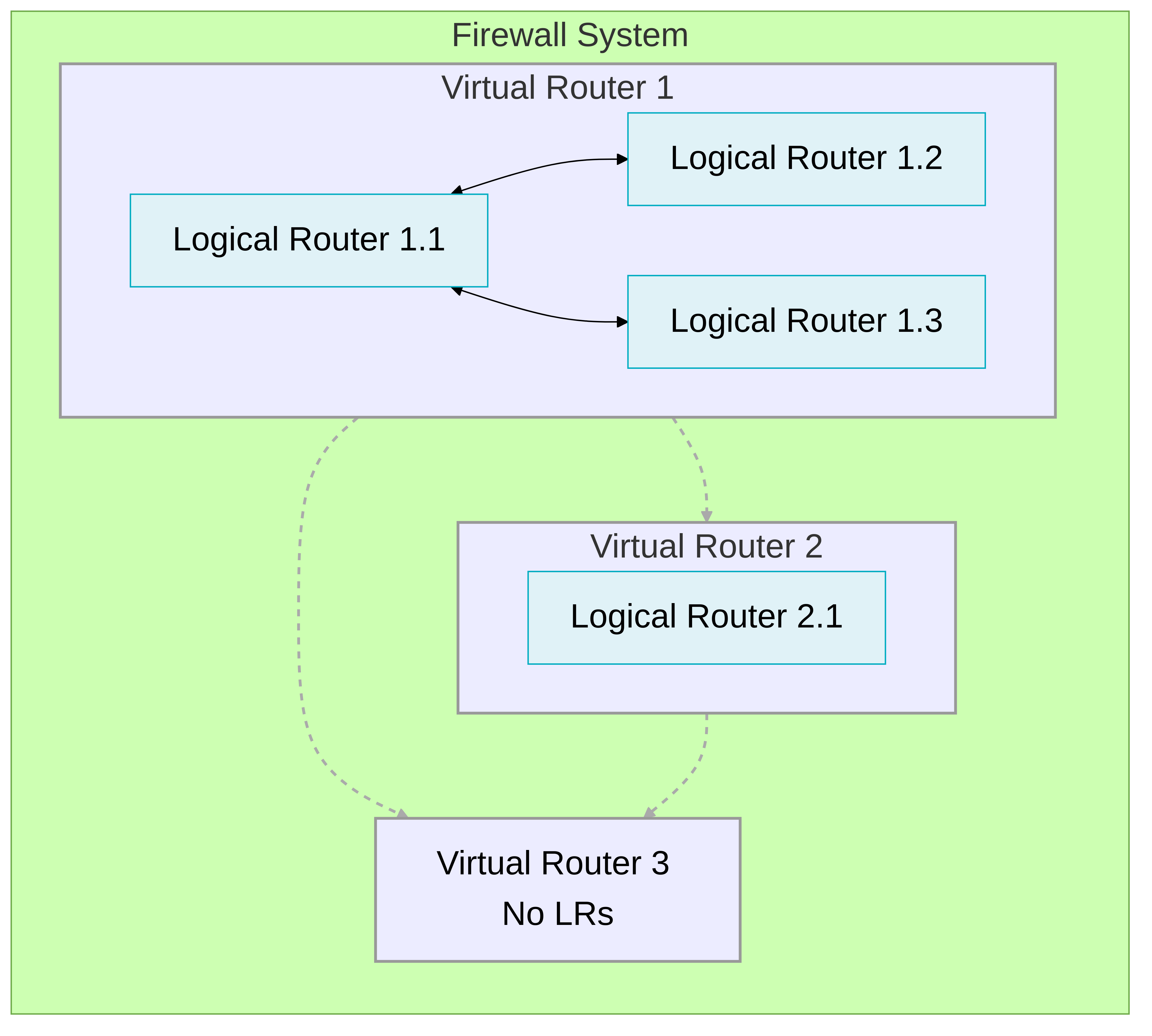Virtual Router vs. Logical Router in PAN-OS
Understanding routing concepts is fundamental for managing Palo Alto Networks Next-Generation Firewalls (NGFWs). Two key components involved in Layer 3 routing are Virtual Routers (VRs) and, more recently introduced, Logical Routers (LRs) . While conceptually similar, they have distinct characteristics and use cases.
This article provides a comprehensive comparison of VRs and LRs, focusing on aspects relevant to the PCNSE exam, including their definitions, differences, use cases, inter-router communication, and visual aids to solidify understanding.
Virtual Routers (VRs) - The Foundation
Think of a Virtual Router (VR) as a software-based router instance running within the firewall.
Key Characteristics:
- Independent Routing Table: Each VR has a completely separate routing information base (RIB) and forwarding information base (FIB). Routes in one VR are not automatically known by another.
- Interface Association: Layer 3 interfaces (Physical Ethernet, VLAN, Tunnel, Loopback) are directly assigned to a specific VR.
- Default Instance: By default, a PAN-OS firewall comes with a pre-configured VR named `default`. Simple deployments often use only this default VR.
- Routing Protocols: Supports static routes and dynamic routing protocols (BGP, OSPF, RIPv2, Multicast).
- Routing Profiles: In the legacy routing engine (associated primarily with VRs), routing profiles (like BGP peer group configurations, redistribution profiles) are unique to the VR where they are configured and cannot be shared between VRs.
Common Use Cases:
- Basic Network Segmentation: Separating major network segments like Internal (Trust), External (Untrust), and DMZ into different routing domains.
- ISP Redundancy: Using separate VRs for different ISP connections, although this can also be achieved within a single VR using techniques like PBF or path monitoring.
- Simple Multi-Tenancy: Providing distinct routing environments for different departments or tenants, although this can become complex to manage at scale.
Logical Routers (LRs) - Advanced Routing & Scalability
Logical Routers (LRs) were introduced with the Advanced Routing Engine (ARE) , starting in PAN-OS 10.2.
Key Characteristics:
- Exist Within a VR: An LR is always a component of a parent VR. It doesn't exist independently.
- Separate Routing Tables: Like VRs, each LR maintains its own distinct routing table, allowing for overlapping IP address spaces between LRs within the same VR.
- Interface Association: Interfaces are still primarily associated with the parent VR, but can then be assigned to participate in a specific LR within that VR.
- Shared Routing Profiles: A major advantage of the ARE and LRs is that routing profiles (e.g., for BGP, OSPF, route maps, prefix lists) are configured globally or within the parent VR's scope and can be shared and reused across multiple LRs. This simplifies configuration and enhances scalability, especially in complex BGP environments.
- No Default LR: Unlike VRs, there is no default LR created automatically when ARE is enabled. LRs must be explicitly configured.
- Enhanced Routing Features: The ARE brings more advanced routing capabilities like route maps, enhanced prefix lists, and more granular policy-based redistribution controls, often leveraged in conjunction with LRs.
Common Use Cases:
- Advanced Multi-Tenancy: Providing robust routing separation for multiple tenants or departments sharing the same firewall, especially when overlapping IP addresses are required.
- Network Segmentation with Overlapping IPs: Isolating segments (e.g., different customer networks, lab environments) that use the same private IP ranges.
- Service Chaining / VRF Stitching: Creating specific routing paths for traffic inspection or service insertion by routing traffic between LRs.
- Replacing complex multi-VR designs: Simplifying configurations where many VRs were previously needed solely for routing table separation, especially if routing policy reuse is beneficial.
Key Differences: Virtual Router vs. Logical Router
This table summarizes the crucial distinctions between VRs and LRs:
| Feature | Virtual Router (VR) (Legacy Engine Focus) | Logical Router (LR) (Advanced Routing Engine) |
|---|---|---|
| Engine Requirement | Legacy Routing Engine (Default) | Advanced Routing Engine (ARE) (Must be enabled) |
| PAN-OS Availability | All versions | PAN-OS 10.2 and later |
| Scope / Container | Top-level routing instance | Sub-instance *within* a Virtual Router |
| Creation | `default` VR exists automatically. Additional VRs manually created. | No default LR. Must be manually created. |
| Routing Table | Independent per VR. | Independent per LR (allows overlapping IPs within the parent VR). |
| Interface Assignment | Layer 3 interfaces directly assigned to the VR. | Layer 3 interfaces assigned to the parent VR, then associated with the LR. |
| Routing Profile Sharing | Profiles (BGP, OSPF, Redistribution etc.) are unique to the VR and generally not shared. | Routing profiles are configured centrally (within ARE scope) and can be shared/reused across multiple LRs. |
| Advanced Routing Features | Basic support for standard protocols. | Enhanced support via ARE (route maps, advanced prefix lists, policy-based redistribution). |
| Inter-Instance Communication | Requires explicit static routes (Next VR type) or potentially PBF between VRs. | Supported via static routes (Next LR type), typically using loopback interfaces, often combined with iBGP for dynamic exchange. |
| Primary Use Case Focus | General segmentation, basic routing needs. | Advanced multi-tenancy, overlapping IPs, complex segmentation, scalable routing policy management. |
Use Cases and Choosing Between VR and LR
When to Use Virtual Routers (VRs):
- Simpler Network Designs: For networks with straightforward segmentation (e.g., Trust, Untrust, DMZ) without overlapping IP requirements.
- Legacy Environments: If running PAN-OS versions prior to 10.2 or if the Advanced Routing Engine is not enabled.
- Basic Routing Needs: When only static routes or simple dynamic routing setups are needed without complex policy requirements.
- Maintaining Existing Structure: If migrating from older setups, keeping the existing VR structure might be simpler initially, unless the benefits of ARE/LRs are compelling.
When to Use Logical Routers (LRs):
- Complex Multi-Tenancy: When isolating multiple tenants/departments with potentially overlapping IP addresses within the same firewall.
- Need for Overlapping IP Spaces: Essential if different network segments connected to the same firewall must use the same IP subnets.
- Scalable Routing Policy: When you need to reuse BGP configurations, route maps, or redistribution policies across multiple routing instances to reduce complexity and ensure consistency.
- Advanced Routing Requirements: Utilizing features like route maps, granular prefix lists, and complex redistribution policies offered by the Advanced Routing Engine (ARE).
- New Deployments on PAN-OS 10.2+: For new setups on compatible PAN-OS versions, starting with ARE and LRs often provides more flexibility and aligns with current industry practices.
- Future-Proofing: As Palo Alto Networks develops the ARE further, using LRs positions the configuration for future enhancements.
Decision Scenario:
You are designing a network for a managed service provider using a single PA-5400 series firewall (running PAN-OS 11.1) to serve three distinct customers. Each customer requires their own routing domain, and two customers use the same 192.168.1.0/24 network internally. You need to apply similar BGP peering policies for each customer's connection back to their private networks.
Recommendation: Enable the Advanced Routing Engine and use Logical Routers . LRs are ideal here because:
- They handle the overlapping IP address requirement (192.168.1.0/24).
- They provide strong routing table separation for multi-tenancy.
- Routing profiles (like BGP configurations) can be defined once and reused across the LRs for each customer, simplifying management.
Inter-VR and Inter-LR Routing
Since VRs and LRs maintain separate routing tables, traffic cannot inherently flow between them. Mechanisms must be configured to allow communication when needed.
Inter-VR Routing (Between Virtual Routers):
- Static Routes (Next VR): The most common method. A static route is configured in one VR specifying the destination network, and the next-hop type is set to "Next VR," pointing to the target VR. A corresponding route might be needed in the other VR for return traffic.
- Policy-Based Forwarding (PBF): PBF rules can override the routing table lookup and direct traffic towards an interface connected to another VR, effectively forcing the traffic across the VR boundary based on policy criteria rather than just destination IP.
- External Routing Device: Traffic can be routed out of the firewall from one VR to an external router, which then routes it back into the firewall on an interface belonging to a different VR (less common and efficient).
set network virtual-router VR1 routing-table ip static-route route-to-vr2 destination 10.2.0.0/16 nexthop next-vr VR2
Inter-LR Routing (Between Logical Routers within the SAME VR):
- Static Routes (Next LR): Similar to inter-VR, you configure static routes using the "Next LR" next-hop type, pointing traffic destined for networks in another LR towards that target LR.
-
Loopback Interfaces and iBGP:
This is a common and scalable method, especially when dynamic routing is needed.
- Configure a unique loopback interface within each LR.
- Create static routes of type "Next LR" in each LR pointing to the *loopback IP* of the *other* LR(s).
- Establish an iBGP peering session between the loopback interfaces of the LRs.
- Use BGP to advertise and learn routes between the LRs. Ensure "Next Hop Self" is configured appropriately on the iBGP peers.
- A security policy allowing BGP traffic (typically TCP port 179) between the zones associated with the loopback interfaces is required.
- OSPF Limitation: OSPF requires direct Layer 3 adjacency and cannot typically form neighbor relationships over the "Next LR" static route mechanism used with loopbacks. Using physical interfaces between LRs for OSPF is possible but less scalable.
set network logical-router LR1 routing-table ip static-route route-to-lr2 destination 10.20.0.0/16 nexthop next-lr LR2
set network logical-router LR1 interface loopback.1 ip 1.1.1.1/32
set network logical-router LR2 interface loopback.2 ip 2.2.2.2/32
set network logical-router LR1 routing-table ip static-route route-lr2-loopback destination 2.2.2.2/32 nexthop next-lr LR2
set network logical-router LR2 routing-table ip static-route route-lr1-loopback destination 1.1.1.1/32 nexthop next-lr LR1
# ... then configure iBGP peering between 1.1.1.1 and 2.2.2.2 ...
Diagram: Choosing VR or LR (Flowchart)
This flowchart helps visualize the decision process:

Flowchart guiding the choice between Virtual Routers and Logical Routers based on requirements.
Diagram: Simplified Packet Journey (State Diagram)
This diagram illustrates the high-level states a packet traverses concerning routing instance lookup:

Simplified state diagram showing packet flow involving VR/LR determination and routing lookup.
Diagram: Inter-VR/LR Communication (Sequence Diagram)
Illustrating traffic flow between two routing instances (VRs or LRs) using static 'Next VR/LR' routes:

Sequence diagram showing packet flow between two routing instances using internal next-hop routing.
Diagram: Conceptual Relationship (Graph)
This graph shows the relationship where Logical Routers exist *within* Virtual Routers.

Conceptual graph illustrating that Logical Routers are components nested within Virtual Routers. Dotted lines represent potential configured routing paths between instances.
PCNSE Exam Focus Summary
Based on the Palo Alto Networks PCNSE blueprint and common exam topics, here's what to focus on regarding Virtual and Logical Routers:
- Core Distinction: Clearly understand the fundamental difference: VRs are top-level routing instances, while LRs (requiring ARE) are sub-instances within a VR.
- Engine Association: Know that VRs are associated with the legacy engine (though they exist in ARE too), and LRs *require* the Advanced Routing Engine (ARE) and PAN-OS 10.2+.
- Configuration Differences: Recognize that ARE/LR configurations align more with standard router CLI methodologies and enable profile sharing, unlike the legacy VR approach.
- Use Case Application: Be able to identify scenarios where LRs are specifically advantageous (overlapping IPs, multi-tenancy, profile reuse) versus simpler scenarios suitable for VRs.
- Interface Binding: Understand that interfaces bind to VRs, and LRs then utilize interfaces associated with their parent VR.
- Inter-Instance Routing: Know the basic methods for routing between VRs ('Next VR' static route) and between LRs ('Next LR' static route, iBGP over loopbacks).
- Terminology: Be comfortable with the terms "Virtual Router," "Logical Router," "Advanced Routing Engine," "Legacy Routing Engine," "Next VR," and "Next LR."
Potential PCNSE Questions (Based on Web Findings)
While exact exam questions are confidential, discussions and study materials online suggest questions similar to these might appear:
- An administrator needs to enable BGP on a firewall running PAN-OS 11.0 with the Advanced Routing Engine enabled. Where are BGP settings primarily configured in this scenario? (Hint: Associated with Logical Routers).
- A company is migrating its firewall configuration to use the Advanced Routing Engine. They previously had multiple Virtual Routers with identically named BGP routing profiles. What potential issue might they encounter during migration? (Hint: Profile sharing in ARE vs. uniqueness in legacy).
- Which routing construct must be used if a deployment requires isolating two network segments that use the same 10.10.0.0/16 IP address range behind a single firewall running PAN-OS 10.2 or later? (Hint: Overlapping IPs).
- What is the primary mechanism recommended for establishing dynamic routing between two Logical Routers residing within the same Virtual Router? (Hint: iBGP over loopbacks).
- An administrator configures a static route in VR-Internal with a next-hop type of 'Next VR' pointing to VR-External. What is the purpose of this configuration? (Hint: Inter-VR routing).
- Which feature, significantly enhanced by the Advanced Routing Engine, allows for the reuse of routing policies like redistribution profiles across multiple Logical Routers? (Hint: Shared Routing Profiles).
- When configuring a Layer 3 interface on a Palo Alto Networks firewall, which two logical constructs must it typically be associated with? (Choose two). (Hint: Zone and Virtual Router).
- True or False: A default Logical Router is automatically created when the Advanced Routing Engine is enabled. (Hint: False).
Look for questions that test your understanding of the *differences* in capabilities and configuration between the legacy (VR-centric) and advanced (LR-centric) routing engines.
PCNSE Style Quiz: Virtual vs. Logical Routers
Test your understanding with these 20 questions: